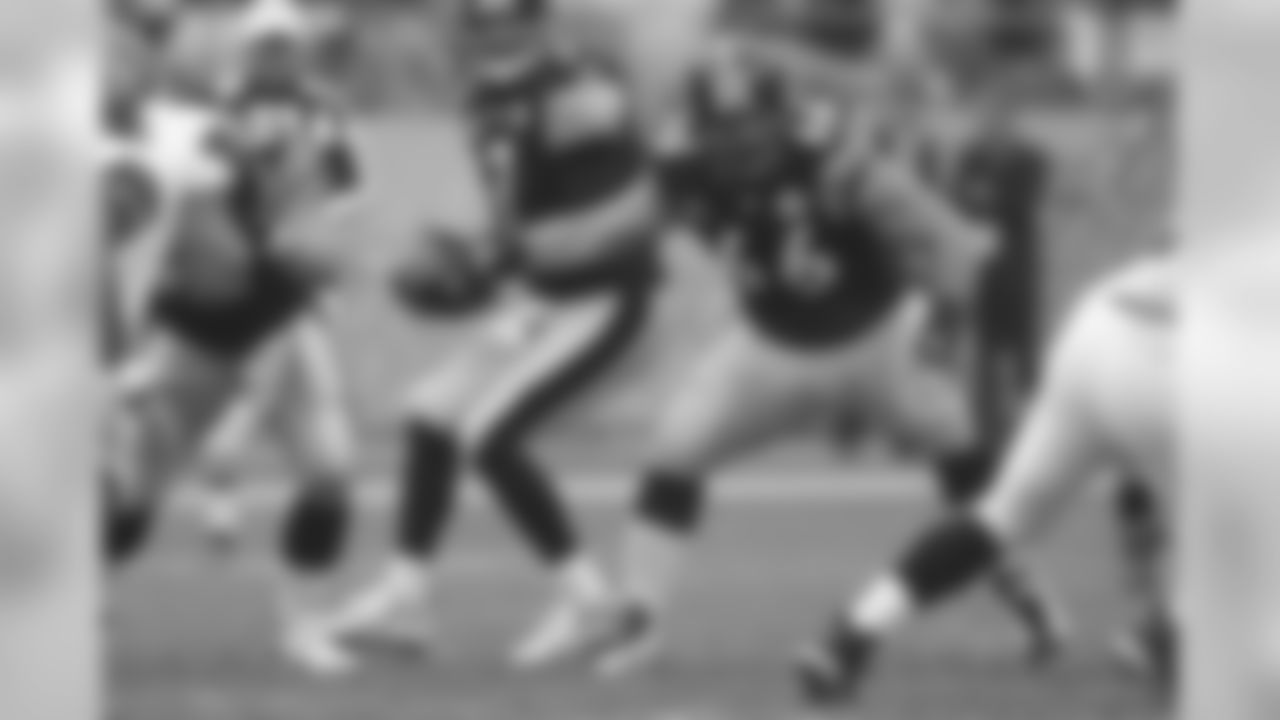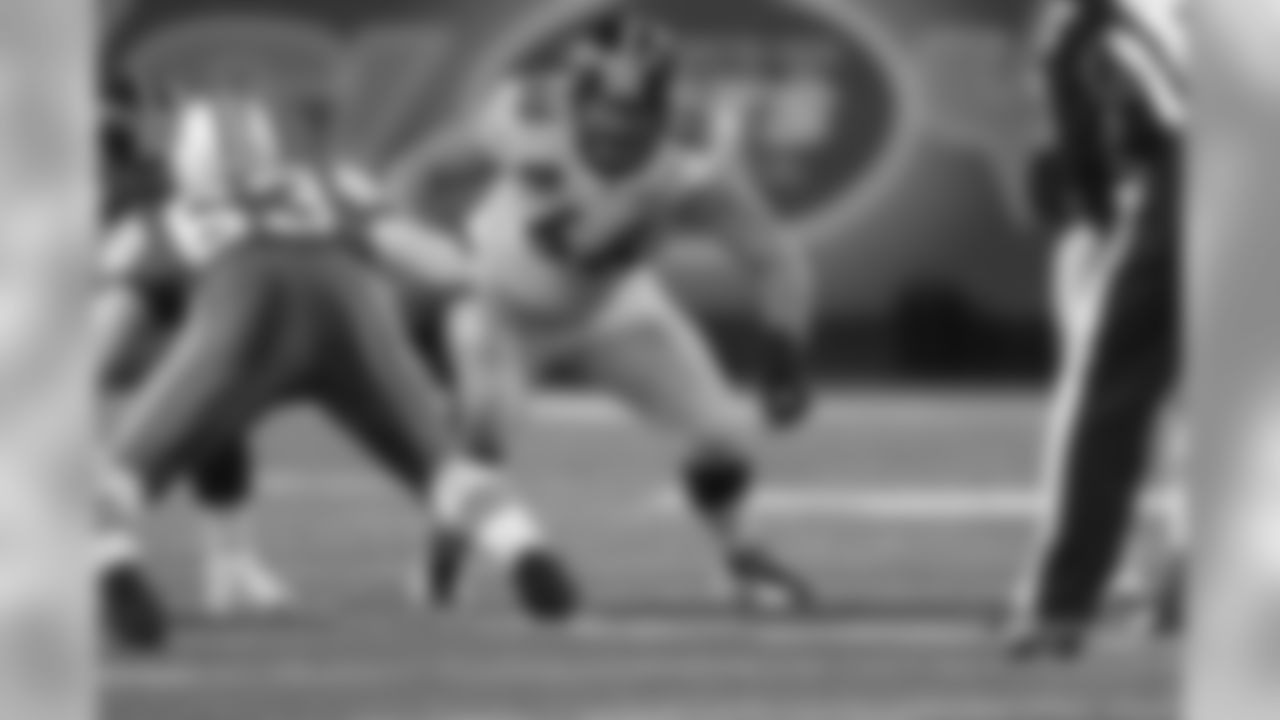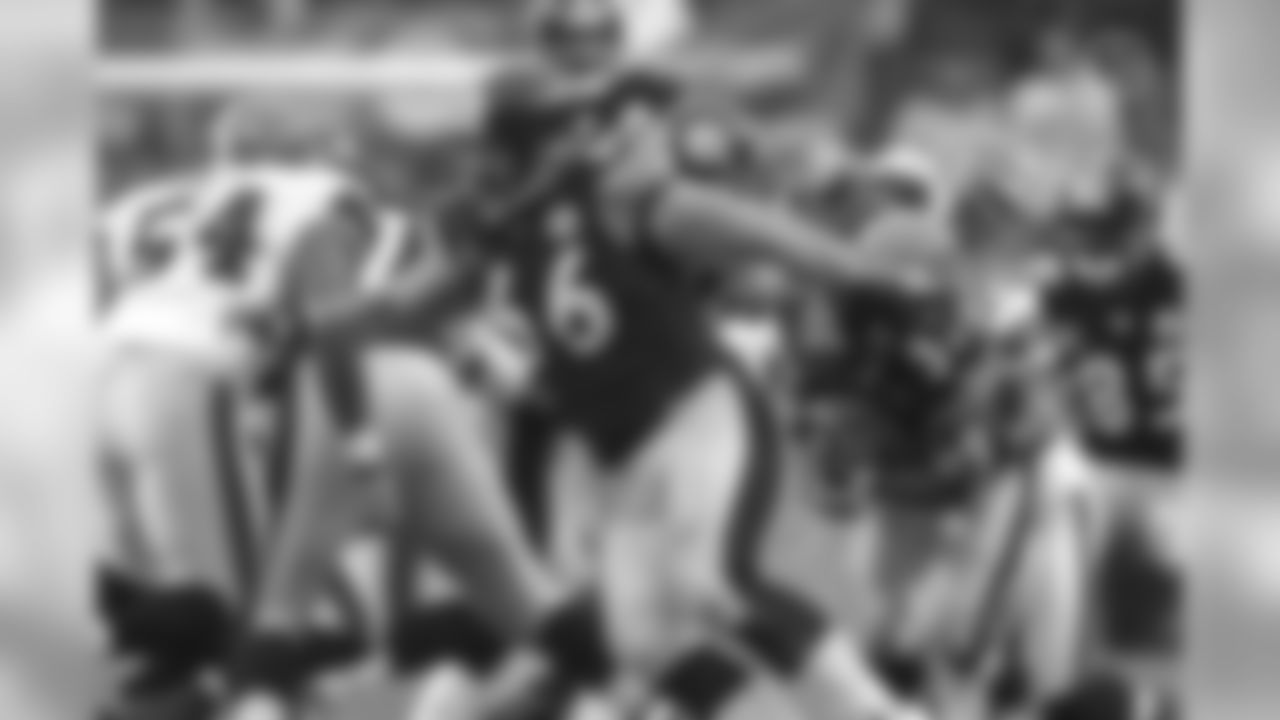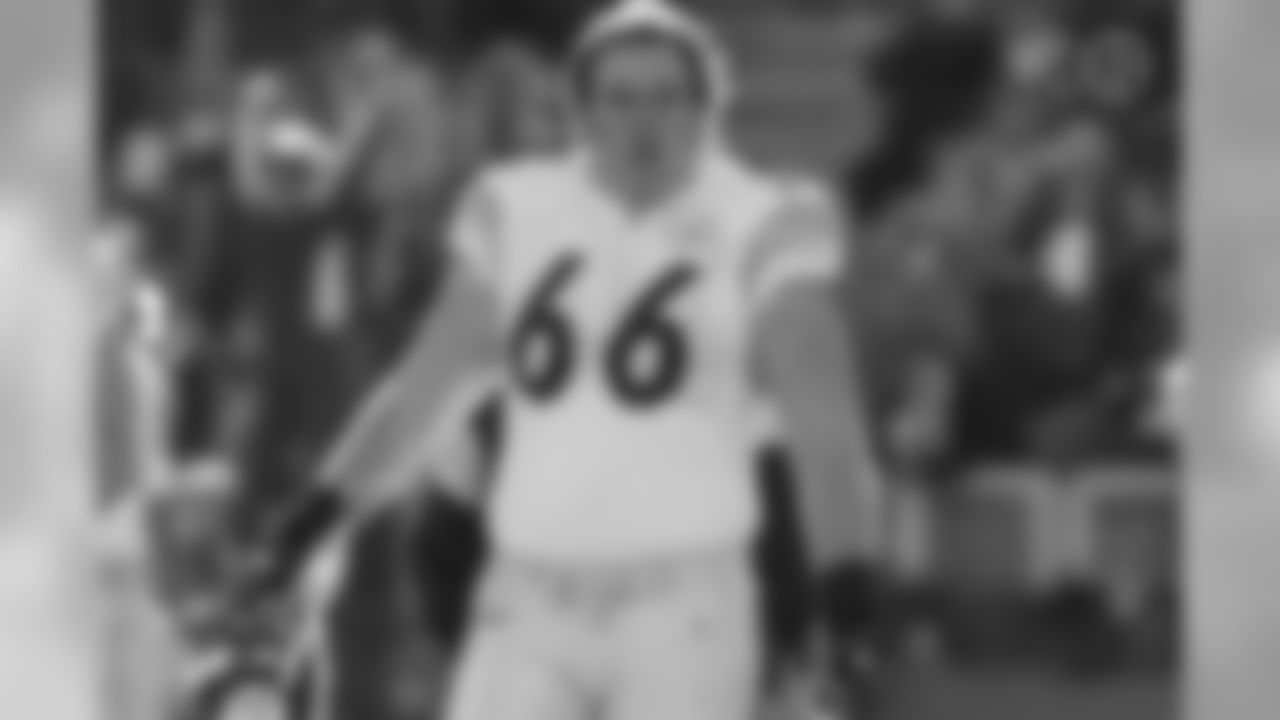EDITOR'S NOTE: FOR THE FIFTH TIME, ALAN FANECA IS ONE OF THE 15 MODERN ERA FINALISTS FOR INDUCTION INTO THE PRO FOOTBALL HALL OF FAME, THIS TIME AS PART OF THE CLASS OF 2020. VOTING WILL TAKE PLACE ON SATURDAY, FEB. 1, IN SOUTH FLORIDA AT THE SITE OF SUPER BOWL LIV. THE WINNERS WILL BE ANNOUNCED ON SATURDAY NIGHT AS PART OF NFL HONORS, WHICH WILL BE BROADCAST ON FOX AT 8 P.M. FROM THE ADRIENNE ARSHT CENTER IN DOWNTOWN MIAMI.
It's different with guards. More difficult. Much more difficult.
It's more difficult for a number of reasons, and it begins with the lack of statistics, in particular the lack of the kind of statistics that can fill in a lot of the blanks on a Hall of Fame resume. Sure, there are some statistics for guards, but most of them can trend toward the obscure that only can be appreciated by true football nerds, and the others trend toward being unreliable.
Take Pro Bowl appearances and All-Pro teams made as a couple of examples of the unreliable.
Now that the Pro Bowl has been moved up to the week between the Conference Championship games and the Super Bowl, there could be a bunch of players selected from the league's two best teams in a particular year who are unable to appear because they have more important business at hand the following Sunday, and they have to be replaced. Then there are the injured or those who will need offseason surgery and prefer to get it done ASAP to begin the rehabilitation process, and they have to be replaced. Then there are the been-there, done-that guys, who either have become bored with the all-star game experience, or disappointed that the free vacation is now in Florida instead of Hawaii, and they have to be replaced. By the time the squads assemble for the week of practice/festivities, one conference's starting lineup could contain the guards who finished third and fourth in the voting, with the other conference's starters could be the guards who finished sixth and seventh in the voting.
And while it's still nice to be recognized as one of the best 15-or-so guards in the league in any given year, and even if it turns out to be a nice (translated: free) vacation for the family of a dad who largely has been unavailable for the better part of six full months, it doesn't exactly compel anyone want to associate Hall of Fame with such recognition.
Being voted to the Associated Press All-Pro team is more significant, to be sure, but like the Pro Bowl it comes down to a vote, and the thing with all elections are these two things: at their core each election is nothing but a popularity contest, and when all of the ballots are counted we end up having learned more about the voters than we have about the candidates.
And really, the whole Pro Bowl/All-Pro process brings us back to the lack of easily digestible statistics. When players are filling out their Pro Bowl ballots, how many would you guess have a good working knowledge of the best guards in their conference, and even beyond that, how many of them even know what talents and characteristics go into being a good NFL guard? Therefore what can happen that when the voter comes to the offensive line positions, instead of studying video or relying on a detailed understanding of the intricacies of interior offensive line play, he simply turns to the guy in the chair next to him and says, "Who was the left guard last year?" Then he votes for him.
Maybe this is why guards are so underrepresented in the Pro Football Hall of Fame. Only three guards were elected from the Modern Era category in the past 10 years. Guards make up only 6.6 percent of all Hall of Fame players — 18 of 273. So what's to distinguish the guards who are deserving of enshrinement? And even more significantly, what might turn out to be the difference that convinces the members of the Board of Selectors to vote for Alan Faneca?
In college football, there is something referred to as "a Heisman moment" when it comes to distinguishing candidates who are in the running for the Heisman Trophy, the award given annually to the "most outstanding player in NCAA football. For obvious reasons, here it will be known as "a Canton moment." The other potentially significant element are the testimonials, the "takes one to know one" praise from the lions of the industry.
Faneca's resume contains both. He actually has "a Canton moment," which is noteworthy in the first place because such things are rare for offensive linemen, and the testimonials all come from people already enshrined in the Pro Football Hall of Fame, a couple coming from rivals.
FANECA'S CANTON MOMENT
Alan Faneca entered the NFL in 1998, and at the time Jimmy Johnson, who had won a national championship at the University of Miami and constructed/coached the Dallas Cowboys team that won two Super Bowls, was the coach of the Miami Dolphins. In other words, he had an eye for good college players, and he understood what a college player had to have in order to become successful in the NFL, and in 1998 he was looking to bring some of those types of people to South Florida. During a pre-draft interview, in the process of evaluating the pool of talent available, Johnson stated that of all the prospects he had scouted "the one most ready to come into the NFL and play right away is that guard from LSU."
The Steelers made that guard from LSU the 26th pick in the first round, and Faneca joined a team that had qualified for the playoffs in each of the previous six seasons, that had reached the AFC Championship Game in three of those six seasons, a team that had lost Super Bowl XXX at the end of the 1995 season to the Cowboys team Johnson was responsible for putting together.
In 1998, the Steelers were coming off an AFC Championship Game loss at Three Rivers Stadium to eventual Super Bowl champion Denver, and that season their offense finished with 2,479 rushing yards, a 4.3 average, and 19 rushing touchdowns, while allowing 20 sacks on 466 pass attempts. Not exactly in desperate need of help from a rookie lineman, even one who was ready to play right away. So Faneca spent the first month of the season in uniform on game days but not in the starting lineup, until the Steelers came back from their bye for an Oct. 11 game in Cincinnati. Beginning with that game, Alan Faneca was in the starting lineup, and of all the things that would change for both the Steelers and the National Football League, Faneca being in the starting lineup would not. Besides those first four games of his rookie year, Faneca would miss only one more start over the course of a 13-year professional career, and that came in 2001 when Coach Bill Cowher chose to rest a bunch of his significant players in a meaningless regular season finale on the way into the playoffs as the No. 1 seed in the AFC.
Fast forward to the 2003 regular season, and the Steelers were facing a road game against the Denver Broncos without injured starting left tackle Marvel Smith. Coming off back-to-back division titles, the Steelers were 2-3 when they boarded the plane for the flight to Denver, and without their starting left tackle and needing to protect a quarterback in Tommy Maddox who was the polar opposite of mobile, the team came up with a unique but seemingly suspect strategy. In passing situations, the Steelers would send Keydrick Vincent into the game to play left guard and slide Faneca out to left tackle.
Think about that. Slide a guard, who hadn't played tackle in college or to this point as a pro, to left tackle against a team that got most of its sacks from the defensive ends for a game at a venue where the crowd noise makes it one of the toughest in the league for a visiting team. How could that ever work? Thanks to Faneca, it did. Not well enough for the Steelers to win the game, but well enough to give them a chance to win because of a 13-play, 74-yard touchdown drive that ended with a 1-yard run by Jerome Bettis and then a 2-point conversion run by Bettis that tied the game with 2:41 left in the fourth quarter. That the Steelers didn't win had nothing to do with an offensive line that allowed no sacks on the 10 pass attempts during the tying drive.
"We brought a left guard in on third down and put Alan out at left tackle," said Coach Bill Cowher, HOF, Class of 2020. "People would bring in receivers, we brought in linemen so we could move Alan to left tackle. He had that kind of versatility, that kind of amazing feet, and his athleticism was unique for how powerful he was."
Faneca started nine games at left tackle in 2003 because of injuries to Smith, and so it became the only time between 2001 and 2007 that he did not make first-team All-Pro at guard. He made second team.
"Alan Faneca was one of the best offensive linemen I ever played with," said Bettis, HOF Class of 2015. "He 100 percent was the best guard I ever had the pleasure of running behind because he could do everything at his guard position. He also played tackle for us when we needed him to fill in at tackle. He was just that talented, where he had the ability to play guard, to play tackle, he probably could've played center if we needed him to do that."
MOBILE, AGILE, HOSTILE
With the exception of the 2002-03 seasons when the Steelers lost their way offensively after being seduced by what deserves to be viewed as the Tommy Maddox Mistake, this was a team that depended on running the football, and the way they chose to run the football had nothing to do with finesse. That mind-set was why they traded for Bettis, why they employed fullbacks Tim Lester, Jon Witman, and Dan Kreider during Bettis' career and had them log significant playing time while hardly ever touching the football, and why they elected to spend the 26th pick of the first round of the 1998 NFL Draft on a guard from LSU.
Because he had to make his living running the football between the tackles into the teeth of the opposing defense every week of every football season, Bettis knows a lot about offensive line play because his professional life depended on it. When you listen to Bettis talk about offensive line play and how Alan Faneca went about his business for the eight seasons the two of them were together, it becomes apparent it's more about one teammate trying to help a brother get fitted for a gold jacket.
"Alan was a really unique guard because he had the ability to be mobile," Bettis begins. "He was over 300 pounds and so he was physical at the point of attack, but he was the one who whenever we needed a guard to pull, Alan was the one who would pull because he was able to read on the run, he was agile enough to get around the corner and make the play when we absolutely needed him to make the play. But he was also strong enough that he could deal with the interior rushers who were trying to get to the quarterback. He was equally as good in the running game as he was in the passing game, and that is rare for a guard. He was just special."
Bettis said he remembers a game against the New York Jets where he was supposed to run a sweep behind a pulling Faneca. The way Bettis remembered it, Faneca lost his footing as he turned the corner to cut upfield, which meant the back was going to have to make something happen himself to be able to get across the line of scrimmage and into the secondary. In the milliseconds Bettis was pondering what his options might be with a pulling guard no longer in front of him, he saw Faneca bounce to his feet, gather himself, and still find a way to clear the defender out of the hole.
"You knew he was going to be in that foxhole with you every step of the way," said Bettis. "He never had any quit in him, he was always going to be right there next to you and would fight until there were zeroes on the clock. He was a special teammate."
During Bettis' time in Pittsburgh, the Steelers always were in the same division as the Baltimore Ravens, and there also was a six-season span when Houston/Tennessee and Jacksonville were division rivals as well. That meant six games every season against opponents that understood the importance of stopping the run and committed themselves to doing just that every time they faced the Steelers.
"Whenever we played those teams that were real physical up front and had really good linebackers, Alan was especially beneficial for me because I always knew what he was thinking and he knew what I was thinking," said Bettis. "That's because he was attacking the game the same way I was attacking the game. I was always a thinker on the field, because I knew I had to make the right decision, and whenever I ran behind Alan I knew he always made the right decision on how to attack a guy. If that linebacker was playing with a lot of speed, then he would wash him over the hole. If that linebacker was being real physical, then Alan would take him on and he would leave a little area for me to get through. He was so smart in how he finished the blocks because he knew I was going to be coming right off his butt, so he did small things like moving his body out of the way right when he knew I was about to hit the hole. That's just so rare to see something like that. Also depending on the defender we were going against, he knew the strengths and weaknesses of the other guy, so he was always playing to those strengths and weaknesses. I knew whenever I was going to his side, there always was going to be a soft spot for me to hit."
TAKES ONE TO KNOW ONE
During that same era, Mike Munchak served as the offensive line coach for the Oilers/Titans as he was waiting to be inducted into the Hall of Fame for his own stellar career as a left guard. He got a chance to see a lot of Faneca, both in person and on video.
"As a line coach at the time with the Titans, I got to watch a lot of tape, so I got to watch him quite a bit," said Munchak, HOF, Class of 2001, "and also I watched him coming out of college. Loved him in the first round to the Steelers. Just loved his tenacity, his endurance, his work ethic, how he played the game week in and week out. Didn't matter what the weather was. You see him in the Steelers uniform, long hair, beard. That running game that they had … tough guy … he fit the mold. A very dominant football player. The consistency, no matter who he played against, the results were the same. He made guys around him better. The center around him better, the tackle around him better. He made the team better, and that is what special players do in the offensive line.
"Alan Faneca showed up every day for 13 seasons and dominated in the trenches, and that's hard to do for over 200 games. He was well decorated for that – by his peers with all the Pro Bowl appearances, by the media with the All-Pro votes – people recognized his work for over a decade. Just one of the best players to ever play the position."
Take a look at some of the best photos of G Alan Faneca

Candid shot of Alan Faneca on the sidelines during a game against the Chicago Bears in 2005.

Action shot of Alan Faneca.




Pittsburgh Steelers' Alan Faneca holds up the Vince Lombardi Trophy after defeating the Seattle Seahawks, 21-10, in the Super Bowl XL football game Sunday, Feb. 5, 2006, in Detroit. (AP Photo/Michael Conroy)




Jerome Bettis and Alan Faneca celebrate during a game against the Chicago Bears.


Candid shot of Alan Faneca on the bench during a pre-season game against the Miami Dolphins in 2005.

Candid shot of Alan Faneca during a game against the Green Bay Packers in 2005.



Candid shot of Alan Faneca during a game against the Detroit Lions in 2006.

Action shot of Alan Faneca.

Candid shot of Alan Faneca.

Alan Faneca poses with Jerome Bettis in the clubhouse after the game against the Detroit Lions.
URLACHER: HE WAS THE BEST GUY ON THAT OFFENSIVE LINE
Twelve games into the 2005 regular season, the Steelers were 7-5 and their reality was that they needed to win the rest of their games and still get some help just to have a chance to squeeze into the playoffs. The first of those must-win games came against the 9-3 Bears at Heinz Field. At this point, we allow linebacker Brian Urlacher, HOF, Class of 2018, to pick up the story.
"That was the year we were 11-5 and had the best defense in the NFL statistically in yards allowed and points allowed," said Urlacher, "and they beat us up pretty good. A lot of that started up front for them. They pushed us around up front pretty well. Just through Faneca's athletic ability and physicality at the guard position, I think set the tone for their whole team.
"(Faneca) played at such a high level for such a long time. You know who the good players are. We always knew he was a good player. To do it as long as he did it – and as good as his teams were all those years, I think success with a team has a lot to do with it as well and the way you win as a team. They won up front. They ran the ball, they protected their quarterback. Like I said, that started with him. He was the guy up front. In my opinion, he was the best guy on that offensive line."
To supplement Urlacher's memory with some statistics, the Steelers won the 13th game of the 2005 regular season, 21-9, largely on the strength of 190 rushing yards and two rushing touchdowns that led to a 14-minute edge in time of possession.
That 2005 season ended for the Steelers with a 21-10 victory over Seattle in Super Bowl XL, and it was Faneca who helped deliver a gut-punch to the Seahawks on the second play of the second half. The play was to be a run around the right side, and as Bettis previously explained, "Alan was the one who would pull because he was able to read on the run, he was agile enough to get around the corner and make the play when we absolutely needed him to make the play."
The second half of the Super Bowl certainly qualifies as a time "when we absolutely needed him to make a play," and Faneca got his 300-plus pounds around the corner in front of Willie Parker, and, again as Bettis previously explained, "He was so smart in how he finished the blocks because he knew I was going to be coming right off his butt, so he did small things like moving his body out of the way right when he knew I was about to hit the hole." Faneca moved his body out of the way just as Parker hit that hole at top speed and raced 75 yards untouched for what still is the longest rushing touchdown in Super Bowl history.
LEWIS: HE CONTROLLED THE TEMPO OF THE FRONT SEVEN
There was nothing as physical, as bitter, as violent as Steelers vs. Ravens during the 2000s. Both teams' offenses were committed to running the football, and both defenses were just as committed to making sure that didn't happen. There were games where progress wasn't measured so much in yards, but in feet. Hand-to-hand combat was waged in that patch of grass between the offensive tackles and stretching a few yards in each direction beyond the line of scrimmage. That's where Ray Lewis, HOF, Class of 2018, did battle, and in the annual home-and-home series with the Steelers he often did battle with Alan Faneca.
"He was one of the guards who controlled the tempo of the front seven," said Lewis. "That's what made him so dominant, and when you start to learn guards, which a lot of linebackers don't understand guards, he was the leader in that group. I'm telling you, you start to watch his technique, and his climb – in the linebacker's world, his climb means how quickly he can get from the first level to the second level of a defense, and he was quick. You're telling your defensive linemen, 'Stay on him. Don't let him climb up to me.' But that's what Alan was so good at, man. He was so dominant in how he could combo block. We called it combo – touch a man, boom, touch a man, move – and when you can influence that much of a defensive line, you're going to have problems on the back end when you're talking about the secondary.
"In Pittsburgh games, with (Jerome) Bettis and all of those backs coming downhill – if Alan is on you and you have to figure out a way to get around him and then deal with those backs? It's not going to end well. Him being so smart in that box, and a lot of people don't understand how much calculation goes on inside the box, and that box is what made Alan so dominant. He understood levels. He understood how much he had to give a rub, how much not. How fast he had to climb. A lot of offensive lineman, you can just beat them because they come up and look at you and try to figure you out. He doesn't have to figure you out. Alan was dominant.
"I think a Hall of Famer is somebody truly who has the career that inspires others to be like them. To be great. Every time Alan Faneca stepped on the field, he was great."
If it's true that it takes one to know one, and after listening to Cowher, Bettis, Munchak, Urlacher, and Lewis speak their pieces, there can be but one conclusion:
Alan Faneca deserves a gold jacket.
TOMORROW: Troy Polamalu














